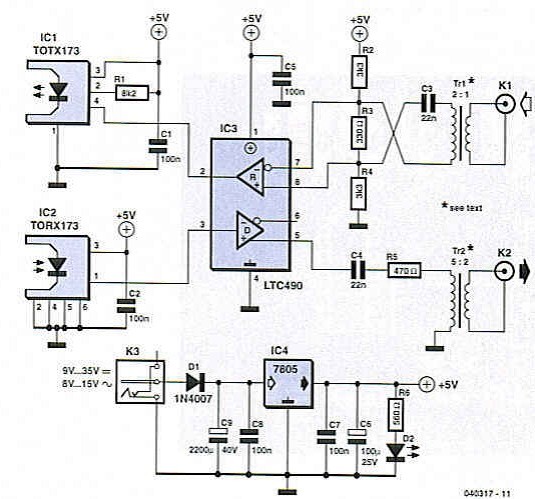

Project Solutions
Bidirectional S/PDIF Converter
Published:2011/8/19 0:49:00 Author:Phyllis From:SeekIC
By Joseph Kranz
Although S/PDIF is the standard when it comes to conveying digital audio signals in consumer electronics equipment, difficulties may be encountered if you try to connect up two apparatus having digital connections. Cheap equipment usually has only one connection (coaxial or optical), while more up-market products will generally offer both variants. When interconnecting CD and DVD players, MD recorders and surround receivers you’ll soon find that a converter from optical to coaxial or the other way around is useful if not indispensable. 
The bidirectional [two-way] S/PDIF converter shown here employs just one IC to handle the conversion both ways. The LTC490 (IC3) is a differential line transceiver originally intended for use in RS485 applications. Using R2, R3 and R4 the driver part used here to get from coaxial to optical is biased to the centre of the permissible common-mode voltage (between -7 V and + 12 V for this IC). Moreover, a small offset is added (approx. 0.2 V) to ensure a low level is defined in the absence of an S/PDIF signal.
The input signal is supplied by Trl, a small transformer you need to wind yourself on an Epcos core type 64290-L44-X830. The primary consists of six turns of 0.3 to 0.5 mm diameter enameled copper wire (SWG30 -SWG26). The secondary side is made by winding 12 turns of the same wire. Incidentally, C3 prevents the transformer secondary from short-circuiting R3. The capacitor has a negligible effect on the /PDIF signal. 
That concludes the more complex part of the circuit, the receiver section of IC3 being followed by a dead standard application circuit around the TOTX173, an optical S/PDIF driver.
The other part of the circuit, i.e., the converter from optical to coaxial, is even simpler. Optical receiver IC2 works happily with the addition of just one capacitor that decouples the supply voltage. The output signal is applied directly to the driver section inside IC3. At the output of that IC, we find another DIY transformer and a coupling capacitor to prevent short-circuiting. Resistor R5 serves to adapt the output level to the S/PDIF standard.
Transformer Tr2 is wound on the same type of core and using the same wire as Trl, but this time with 20 turns at the primary and 8 turns at the secondary.
The home made transformers are, of course, not necessary if you do not require electrical isolation between the input and output signals. In that case, you may replace Trl with a 100-O resistor between ground and the signal line (directly at the input, i.e., ahead of C3). The same applies to Tr2 — this transformer, too, may be replaced by a 100-fl resistor to ground. It, too, is connected directly to the input, so in this case ahead of R5. Note however that R5 then takes a value of 330Ω instead of 470Ω.
We would like to add that this circuit may also prove useful in a computer environment, some sound cards having an on-board S/PDIF output that supplies a signal at TTL level. Such a TTL signal may be applied to the D input of IC3. Components IC2 and C2 are then omitted to add a coaxial S/PDIF output to your trusty PC. Alternatively, the sound card output signal may be applied directly to pin 4 of the TOTX173. If you do so, do not forget to connect the 8.2-k resistor and the 100-nF capacitor (R1 and Cl in the diagram).
The reverse applies as well — you can also use the circuit to apply an S/PDIF signal to the sound card (that is, if it has a TTL compatible input). In that case, components VZ\ , Rl and Cl or C4, R5 and Tr2 are omitted (for the coaxial and optical input, respectively).
The supply section consists of a 7805 voltage regulator in its standard configuration. Diode Dl not only serves as a reverse polarity protection device if a DC-output battery eliminator is used, but also allows the circuit to be powered from an 8-15 VAC source. If you use (parts of) the circuit in combination with your PC, the 5-V supply voltage may, of course, be ’stolen’ from the PC’s power supply. This makes the circuit around IC4 unnecessary, except of course the IC decoupling capacitors Cl, C2 and C5.
Reprinted Url Of This Article: http://www.seekic.com/blog/project_solutions/2011/08/19/Bidirectional_S_PDIF_Converter.html
Print this Page | Comments | Reading(5238)
Article Categories
New published articles
· Imagination works with TSMC to develop FinFET process
Author:Ecco Reading(45489)
· XMOS pushes event-driven MCUs with lower price
Author:Ecco Reading(4141)
· Intel brings upgraded 32-nm SoC for smartphones
Author:Ecco Reading(3864)
· Micron pushes TLC 128-Gbit NAND flash
Author:Ecco Reading(4611)
· Intel will stop supplying desktop motherboards
Author:Ecco Reading(5961)
· Processor market was expected to regain strength in 2013
Author:Ecco Reading(3956)
· It was reported that TSMC sales fall steeply
Author:Ecco Reading(3619)
· Cisco, NXP work with auto wireless startup
Author:Ecco Reading(4282)
· Micron was impacted by manufacturing glitch
Author:Ecco Reading(4647)
· China can make 22-nm transistor by themselves
Author:Ecco Reading(4485)
· Chip market rebound is coming, according to survey
Author:Ecco Reading(4386)
· Sony, Toshiba will spend more on chips, iSuppli reports
Author:Ecco Reading(3953)
· Qualcomm becomes the 13th company to join NFC Forum board
Author:Ecco Reading(6795)
· TSMC increases building work for FinFET fab
Author:Ecco Reading(4467)
· TI plans to cut 1,700 jobs in OMAP shift
Author:Ecco Reading(5327)